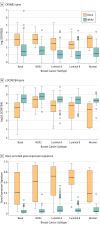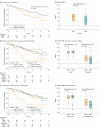Comparison of Breast Cancer Molecular Features and Survival by African and European Ancestry in The Cancer Genome Atlas
- PMID: 28472234
- PMCID: PMC5671371
- DOI: 10.1001/jamaoncol.2017.0595
Comparison of Breast Cancer Molecular Features and Survival by African and European Ancestry in The Cancer Genome Atlas
Abstract
Importance: African Americans have the highest breast cancer mortality rate. Although racial difference in the distribution of intrinsic subtypes of breast cancer is known, it is unclear if there are other inherent genomic differences that contribute to the survival disparities.
Objectives: To investigate racial differences in breast cancer molecular features and survival and to estimate the heritability of breast cancer subtypes.
Design, setting, and participants: Among a convenience cohort of patients with invasive breast cancer, breast tumor and matched normal tissue sample data (as of September 18, 2015) were obtained from The Cancer Genome Atlas.
Main outcomes and measures: Breast cancer–free interval, tumor molecular features, and genetic variants.
Results: Participants were 930 patients with breast cancer, including 154 black patients of African ancestry (mean [SD] age at diagnosis, 55.66 [13.01] years; 98.1% [n = 151] female) and 776 white patients of European ancestry (mean [SD] age at diagnosis, 59.51 [13.11] years; 99.0% [n = 768] female). Compared with white patients, black patients had a worse breast cancer-free interval (hazard ratio, HR=1.67; 95% CI, 1.02-2.74; P = .043). They had a higher likelihood of basal-like (odds ratio, 3.80; 95% CI, 2.46-5.87; P < .001) and human epidermal growth factor receptor 2 (ERBB2 [formerly HER2])–enriched (odds ratio, 2.22; 95% CI, 1.10-4.47; P = .027) breast cancer subtypes, with the Luminal A subtype as the reference. Blacks had more TP53 mutations and fewer PIK3CA mutations than whites. While most molecular differences were eliminated after adjusting for intrinsic subtype, the study found 16 DNA methylation probes, 4 DNA copy number segments, 1 protein, and 142 genes that were differentially expressed, with the gene-based signature having an excellent capacity for distinguishing breast tumors from black vs white patients (cross-validation C index, 0.878). Using germline genotypes, the heritability of breast cancer subtypes (basal vs nonbasal) was estimated to be 0.436 (P = 1.5 × 10−14). The estrogen receptor–positive polygenic risk score built from 89 known susceptibility variants was higher in blacks than in whites (difference, 0.24; P = 2.3 × 10−5), while the estrogen receptor–negative polygenic risk score was much higher in blacks than in whites (difference, 0.48; P = 2.8 × 10−11).
Conclusions and relevance: On the molecular level, after adjusting for intrinsic subtype frequency differences, this study found a modest number of genomic differences but a significant clinical survival outcome difference between blacks and whites in The Cancer Genome Atlas data set. Moreover, more than 40% of breast cancer subtype frequency differences could be explained by genetic variants. These data could form the basis for the development of molecular targeted therapies to improve clinical outcomes for the specific subtypes of breast cancers that disproportionately affect black women. Findings also indicate that personalized risk assessment and optimal treatment could reduce deaths from aggressive breast cancers for black women.
Conflict of interest statement
Figures



Comment in
-
Reported Biologic Differences in Breast Cancer by Race Due to Disparities in Screening.JAMA Oncol. 2018 Jun 1;4(6):883. doi: 10.1001/jamaoncol.2017.5906. JAMA Oncol. 2018. PMID: 29543935 Free PMC article. No abstract available.
-
Reported Biologic Differences in Breast Cancer by Race Due to Disparities in Screening-Reply.JAMA Oncol. 2018 Jun 1;4(6):883-884. doi: 10.1001/jamaoncol.2017.5909. JAMA Oncol. 2018. PMID: 29543936 No abstract available.
References
-
- Torre LA, Bray F, Siegel RL, Ferlay J, Lortet-Tieulent J, Jemal A. Global cancer statistics, 2012. CA Cancer J Clin. 2015;65(2):87-108. - PubMed
-
- Siegel RL, Miller KD, Jemal A. Cancer statistics, 2015. CA Cancer J Clin. 2015;65(1):5-29. - PubMed
-
- DeSantis CE, Fedewa SA, Goding Sauer A, Kramer JL, Smith RA, Jemal A. Breast cancer statistics, 2015: convergence of incidence rates between black and white women. CA Cancer J Clin. 2016;66(1):31-42. - PubMed
-
- Daly B, Olopade OI. A perfect storm: how tumor biology, genomics, and health care delivery patterns collide to create a racial survival disparity in breast cancer and proposed interventions for change. CA Cancer J Clin. 2015;65(3):221-238. - PubMed
-
- Carey LA, Perou CM, Livasy CA, et al. . Race, breast cancer subtypes, and survival in the Carolina Breast Cancer Study. JAMA. 2006;295(21):2492-2502. - PubMed
Publication types
MeSH terms
Substances
Grants and funding
- U01 CA179715/CA/NCI NIH HHS/United States
- U54 CA156733/CA/NCI NIH HHS/United States
- U24 CA143882/CA/NCI NIH HHS/United States
- P50 CA125183/CA/NCI NIH HHS/United States
- U01 CA161032/CA/NCI NIH HHS/United States
- U24 CA143866/CA/NCI NIH HHS/United States
- U54 CA156735/CA/NCI NIH HHS/United States
- U54 HG003273/HG/NHGRI NIH HHS/United States
- P50 CA058223/CA/NCI NIH HHS/United States
- U24 CA144025/CA/NCI NIH HHS/United States
- U24 CA143840/CA/NCI NIH HHS/United States
- U24 CA143843/CA/NCI NIH HHS/United States
- U24 CA143858/CA/NCI NIH HHS/United States
- U24 CA143848/CA/NCI NIH HHS/United States
- U54 HG003079/HG/NHGRI NIH HHS/United States
- U24 CA210949/CA/NCI NIH HHS/United States
- U24 CA143867/CA/NCI NIH HHS/United States
- U24 CA210990/CA/NCI NIH HHS/United States
- P30 ES010126/ES/NIEHS NIH HHS/United States
- P30 CA016672/CA/NCI NIH HHS/United States
- U54 HG003067/HG/NHGRI NIH HHS/United States
- U24 CA143835/CA/NCI NIH HHS/United States
- U24 CA210950/CA/NCI NIH HHS/United States
- U24 CA143845/CA/NCI NIH HHS/United States
- U24 CA143799/CA/NCI NIH HHS/United States
- U24 CA210969/CA/NCI NIH HHS/United States
- U24 CA143883/CA/NCI NIH HHS/United States
LinkOut - more resources
Full Text Sources
Other Literature Sources
Medical
Research Materials
Miscellaneous

